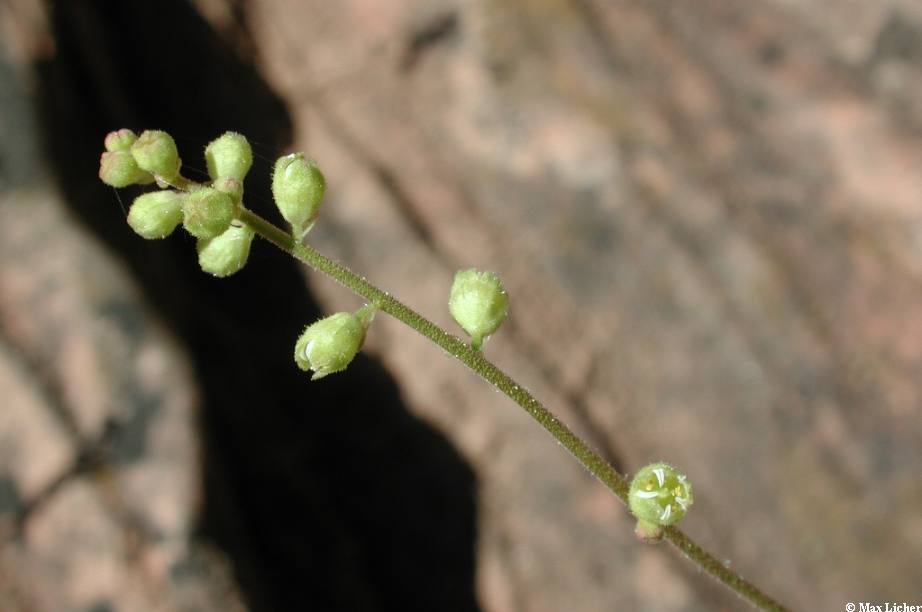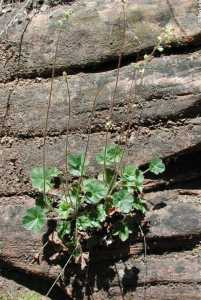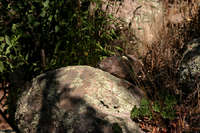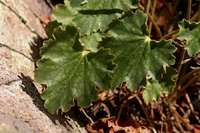|
|
|
|
Family: Saxifragaceae
New Mexico alumroot
|
Plant: Perennial herb Leaves: blades 2-6 cm long, circular-cordate, moderately 7-10 lobed, the lobes crenate; petioles usually densely glandular hairy to hirsute, 2-15 cm long INFLORESCENCE: contracted elongate panicles, almost racemose above, 30-40 cm tall Flowers: 4-6 mm long, cream to yellow-green, glandular puberulent; portion of hypanthium fused to ovary 1-2 mm long, ovoid, shorter than free part; sepals equal, oblong-ovate, occasionally green-tipped, erect; petals 1.5-2.5 mm long, more or less equal to sepals, narrowly oblanceolate; stamens shorter than sepals, the anthers yellow; mature styles shorter than sepals Fruit: FRUITS 2-valved; SEEDS smooth to ridged Misc: Chaparral hillsides and rocky woodlands; 1500-2450 m (5000-8000 ft); Apr-Jun REFERENCES: Elvander, Patrick. 1992. Saxifragaceae. Ariz.-Nev. Acad. Sci. 26(1)2. FNA 2009, Kearney and Peebles 1969 Duration: Perennial Nativity: Native Lifeform: Forb/Herb General: Herbaceous, acualescent perennials, scapose flowering stems 30-50 cm long, with short to long stipitate-glandular surfaces, plants with a branching caudex, the caudex woody and scaly. Leaves: Alternate, nearly all basal, orbicular or broadly ovate, 2-6 cm in diameter, shallowly 5-lobed with dentate margins and cordate bases, surfaces long stipitate-glandular on veins abaxially, glabrous or short stipitate-glandular above, blades long petioled, petioles glabrous to long stipitate-glandular. Flowers: Small, white, petals usually erect, elliptic, unlobed and not clawed, 0.5-1 mm long with entire margins, sepals erect or incurved, green-tipped, equal in length, 0.5-1 mm long with ovate tips, stamens included, to 0.5 mm long, filaments erect or incurved distally, equaling and not concealed by the anthers, styles also included, 0.5-1 mm long and to 0.1 mm wide or more, ovaries partly inferior, 1-celled, petals and stamens inserted on a well-developed, cream or yellowish green, broadly campanulate hypanthium 3-5 mm long, with short stipitate-glandular surfaces, infloresences dense, the flowers borne in narrow racemes or cymose pannicles. Fruits: Pairs of ovoid, divergent, beaked follicles, 5.5-6.5 mm long. Seeds dark brown, asymmetrically ellipsoid or convex-fusiform, to 0.5 mm long, several per follicle. Ecology: Found in mountains, on shaded rocky ledges and outcrops, from 6,000-8,000 ft (1829-2438 m); flowering in June. Distribution: Arizona, New Mexico. Etymology: Heuchera is named after Johann Heinrich von Heucher (1677-1747), professor of medicine and botanist at Wittenberg, Germany; the meaning of novomexicana is unknown. Synonyms: None Editor: LCrumbacher2012 |






